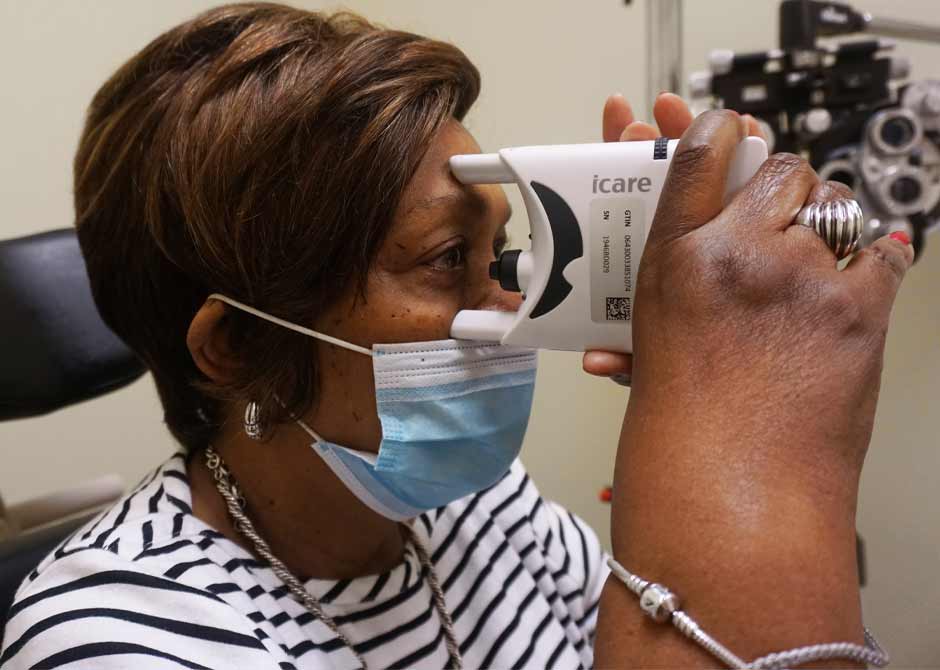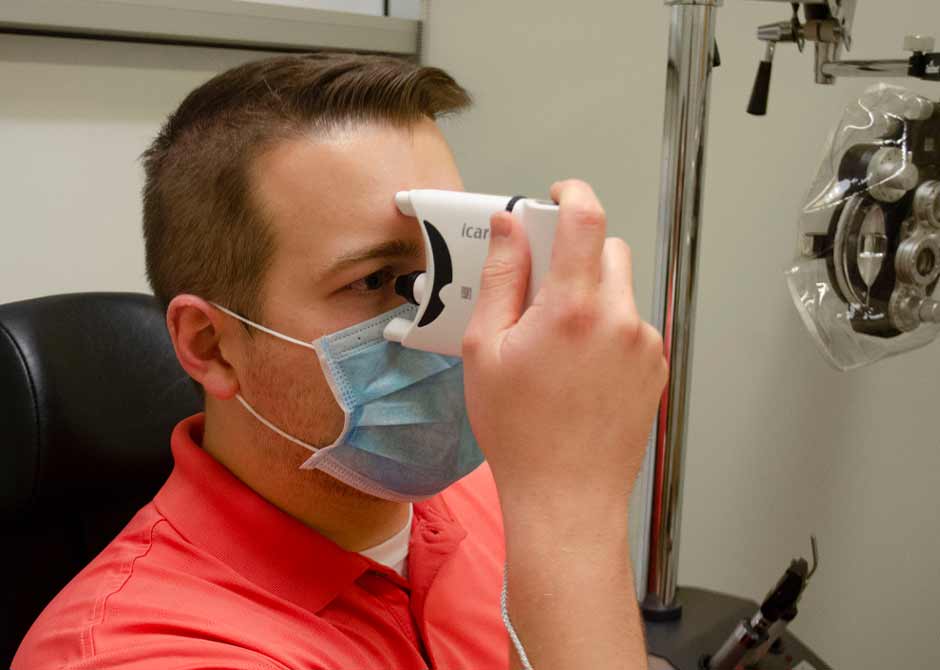The Ohio State University Wexner Medical Center is leading the way in preventing glaucoma vision loss and glaucoma management with iCare Home Monitoring. iCare Home Monitoring uses a handheld device with a tiny, disposable tip that makes momentary contact with the surface of your eye to collect an eye pressure reading.
 Eye pressure and glaucoma
Eye pressure and glaucoma
Just as you have blood pressure within your blood vessels, you have eye pressure (also known as intraocular pressure, or IOP) in the eye. Normal eye pressure is 10 – 21 mmHg. When eye pressure is higher, some people are susceptible to optic nerve damage, which can lead to vision loss. This is called glaucoma.
Glaucoma is gradual, and if left untreated the loss of vision occurs slowly over a long period of time. Thus the majority of people aren’t aware of their vision loss. In addition, the majority of people do not feel pain from their elevated eye pressure as the increase is gradual. But if the eye pressure elevation is sudden and reaches exceedingly high levels, then you may feel eye pain, sense blurred vision, have red eyes and even nausea. Detecting elevated eye pressure early allows for prompt testing to diagnose glaucoma and treatment to help prevent vision loss.
Elevated eye pressure can be caused by:
- An imbalance between the fluid production and fluid drainage in the eye
- Blockage of the fluid drainage in the eye
- Serious eye conditions and diseases
- Certain medications
Similar to blood pressure, eye pressure fluctuates throughout the day, and we can’t predict when the highest pressure will occur. An eye pressure reading in a physician’s office may not capture when your eye pressure is at its highest, or even when it’s elevated.
Importance of regularly monitoring eye pressure
iCare Home Monitoring allows you to easily take eye pressure readings at home throughout the day and night to capture more comprehensive data that your eye doctor can use to assess your eye health.
Pressure readings are taken at home with a small device that positions over the eye by resting on the bones above and below the eye. A tip at the end of the device gently contacts the eye to take the eye pressure reading. This process is painless, doesn’t require numbing drops and takes less than a minute. The eye pressure reading is automatically saved to the device.
Currently, eye pressure is the only treatable risk factor for glaucoma. If you’re at risk for or have been diagnosed with glaucoma, it’s important to have an accurate assessment of your eye pressure data. With this more complete eye pressure data, you and your eye doctor will work together for a treatment plan that works for you with the goal of preventing vision loss from glaucoma.
Who can benefit from iCare Home Monitoring?
You might benefit from iCare Home Monitoring if you are:
- At high risk of developing glaucoma – If you have a family history of glaucoma, you may be at increased risk of developing glaucoma. Gathering data on your eye pressure can help your eye doctor identify and treat elevated eye pressure early and prevent optic nerve damage and vision loss.
- Suspected to have glaucoma – If your eyes are showing borderline tests for glaucoma, your eye doctor might have you use iCare Home Monitoring to track your eye pressure and pinpoint the range of pressure fluctuations. If wide eye pressure fluctuations are detected, then initiating treatment versus continued monitoring using current glaucoma testing can be discussed.
- Diagnosed with glaucoma – If you’ve been diagnosed with glaucoma, iCare Home Monitoring can be used to monitor how well your current treatment keeps your eye pressure in the target pressure range as well as your response to changing treatments.
 Using iCare Home Monitoring
Using iCare Home Monitoring
An Ohio State Wexner Medical Center ophthalmologist trained in iCare Home Monitoring will partner with you and your eye doctor to set you up with this device and technology. If our ophthalmologist determines you’re a candidate for iCare Home Monitoring, you’ll be trained on how to use the device to take an eye pressure reading. Next, you’ll be sent home with the device to take eye pressure readings several times a day for a period of time.
Typically, patients are instructed to take at least four eye pressure readings a day for about two weeks. All readings are securely stored on the device, which you’ll return it to the Ohio State Wexner Medical Center's ophthalmology office. Our ophthalmologist will pull data from the device and analyze it to characterize the low pressure, high pressure, average pressure and variation of the pressure readings.
This eye pressure information can help your eye doctor determine the best treatment plan to lower eye pressure and prevent optic nerve damage and resulting vision loss.

